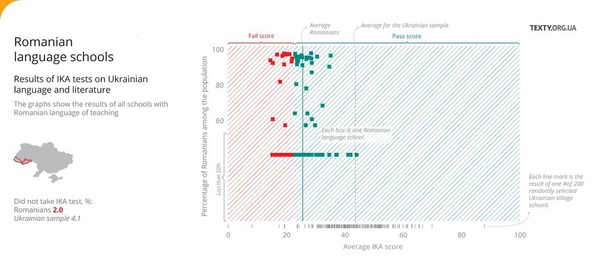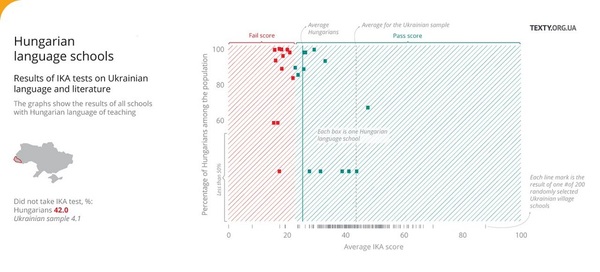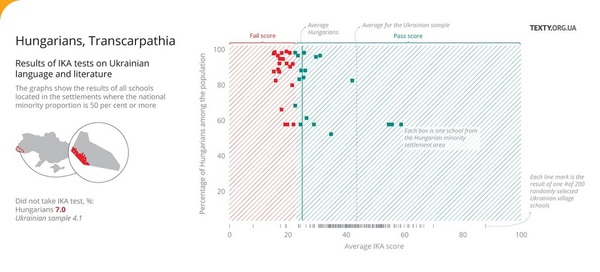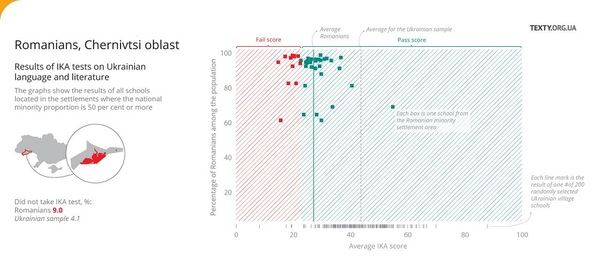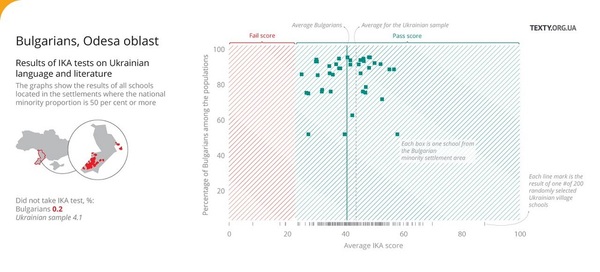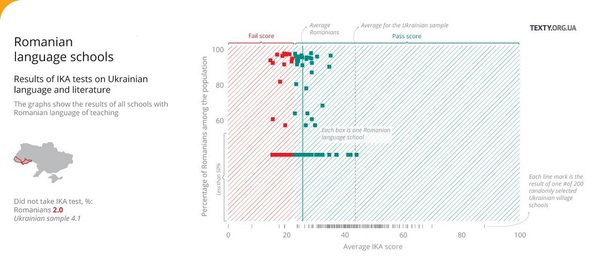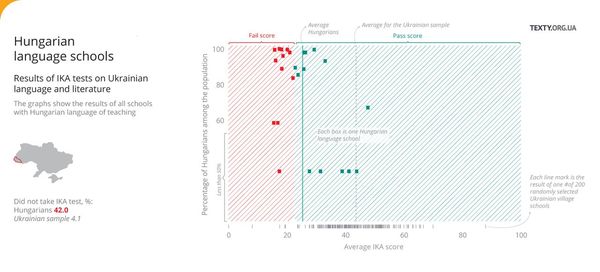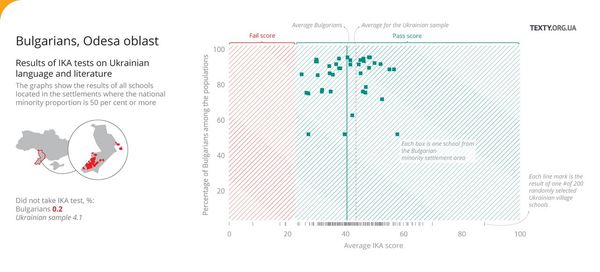They do not understand: Ukrainian Hungarians and Romanians in the schools practically don’t study the state language
The governments of Hungary and Romania protested against the clauses of the new Ukrainian law on education which regulate the use of languages in teaching. We made a research of the proficiency of Hungarians, Romanians and Bulgarians in the obligatory independent knowledge assessment (IKA) on Ukrainian language. The Hungarians turned out to be the least integrated in the Ukrainian society — 42% of Hungarian children do not take this test at all. Romanians demonstrate quite poor testing results. Bulgarians, however, show proficiency comparable to the average country level.
Author: Texty.org.ua
Повний текст статті українською читайте тут
The language-related clauses of the new law on education spurred a vehement response from the representatives of the Hungarian and the Romanian minority. Until recently, the Hungarians and the Romanians had “national schools”, where the classes were held in their languages, while Ukrainian language was taught as a foreign one. The new law implements school education entirely in Ukrainian starting from the 5-th school year.
Back in 2006 the OSCE in its “Note on the Joint Monitoring Missions in Ukraine and Romania” recommended: “More needs to be done to improve teaching of the state language to members of the Romanian minority in Ukraine. Fluency in the state language is a precondition for the integration of persons belonging to national minorities into the wider national society”.
Ukrainian officials emphasize that the representatives of minorities have poorer IKA scores, which means lower chances for a successful career in Ukraine.
Using the IKA results data and the statistics of the Ministry of Education about the number of pupils in each school, we determined, which proportion of the Romanian
and Hungarian language school
graduates pass the Ukrainian language test obligatory for admission to higher education institutions (HEIs). We then matched the results with the scores of the pupils from 200 randomly selected village Ukrainian language schools.
We also investigated, how many school graduates of villages and towns with minority population exceeding 50% take the IKA tests, and what is their performance, and compared the results against those of Ukrainian village school graduates.
Hungarians. 42% do not take IKA test
There are villages in the Transcarpathia region where the proportion of Hungarian population exceeds 90%. They use their mother tongue rather than Ukrainian at home and in everyday communication. Oblast education department considers the absence of proper language environment to be the key reason behind low test scores.
Yulia Tyshchenko, UCIPR expert, explains: “Hungarian schools in the Transcarpathia come up with staunch resistance against implementing parallel Ukrainian and Hungarian language teaching. This is because Hungary has an established system of supporting its schools, teachers and children who attend these schools.
However, Hungarians did approach the Ministry of Education on the matter of implementing Ukrainian language teaching as foreign one. Ukrainian officials did not support this idea”.
The Hungarians in Ukraine follow the closed circle of the national language education, from kindergarten to Ferenc Rakoczi II Transcarpathian Hungarian Institute, and this influences the community's general willingness to pass Ukrainian IKA.
The graduates with good IKA scores have an opportunity to get enrolled into different HEIs in Beregovo and Uzhhorod. They master the state language in Ukrainian-speaking environment in just a few months. However, competition in Uzhhorod National University, the leading HEI of the region, is low. It means that quite a few young people are willing to apply there, while many graduates prefer higher education abroad.
Romanians. IKA uptake is higher, while performance is still low
The graph shows that the majority of graduates from the Romanian schools pass the IKA test. Only 2% (of the Romanian language schools graduates) do not even try it, while this rate among Hungarian language schools graduates is 42%,
and among the graduates of Ukrainian village schools — 4%.
Romania furnishes less support to the Romanian language education in Ukraine, that's why Romanian language graduates are more interested in taking Ukrainian IKA.
Bulgarians. Average level performance
The Education and Science Department of the Odesa Oblast State Administration emphasizes that the school curriculum in Bulgarian villages is taught in Ukrainian. The pupils have only a few hours per week for Bulgarian language and literature classes.
The lack of full-fledged Bulgarian teaching is largely due to the lack of resources — there are no proper textbooks and teachers specializing in different subjects which would have good command of Bulgarian language terminology.
Bulgaria did not opt for assertive support of its education in Ukraine, and this allowed Bulgarians to preserve their language and to be able to get IKA scores on the average level for village schools in Ukraine.
Few graduates (about 2-3%) pursue higher education abroad, teachers say.
Prevalence of the minority language education
Based on the Ministry of Education data, there are 59 entirely Hungarian language and 79 Romanian language schools in Ukraine. This 2016-2017 academic year there were 1,032 pupils of graduate classes and about 12,000 in total in Romanian schools. The Hungarian pupils count is even lower, with 521 in graduate classes and 6,600 in total.
Considering the small scale of the issue, the law, in our opinion, might have contained more lenient provisions on the minority languages. It is necessary to change the situation, but a more flexible approach might be chosen. For example, teaching in middle and secondary school may not be fully switched to Ukrainian language, while bilingual education could be implemented instead: some of the subjects are taught in Ukrainian, while others — in the minority language. This was the solution envisaged by the draft law proposed for voting by the relevant parliamentary committee after the first reading. However, the MPs decided to radicalize the law, allowing bilingual education only for junior school.
Meanwhile, Hungarian organizations opposed even a more lenient option. They favor the current situation, when Ukrainian is taught only as a foreign language. However, the schools are authorized under the current law to teach some subjects in the EU languages, Hungarian and Romanian among them.
The Romanian community is more adherent to the Ukrainian state and Ukrainian language. The MPs might have taken this into account while voting for such sensitive changes.
Our brief journalist investigation showed that the problem is rooted in the lack of methodologies for teaching Ukrainian as a foreign language rather in the reluctance of the minorities to learn it.
We should also mention, that the language matters must be governed by the law “On the Language”, which still is valid in the obsolete “Kivalov-Koleshychenko” edition (pro-Russian MPs who developed this law prior to the Revolution of Dignity). If the language law is not updated, the discussions on which language should be used in the minority settlement areas, and by whom, will continue to spark here and there.


